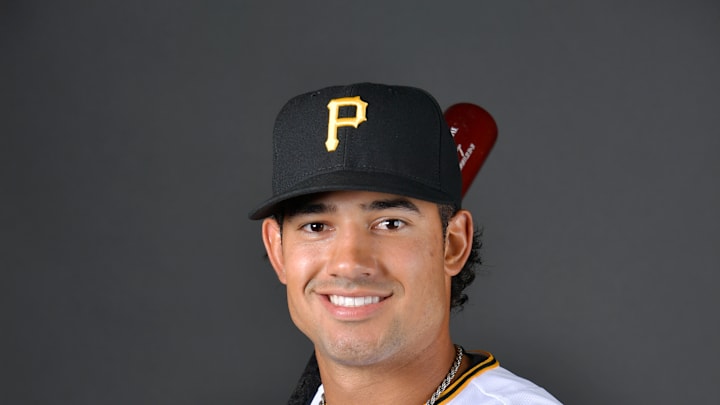Position Players
The big name we'll get out of the way first is Endy Rodriguez. The switch-hitting catcher batted 323/.407/.590. Rodriguez's 11.3% walk rate and 19% strikeout rate was the fourth year in a row the backstop had a sub-20% strikeout rate and walk rate above 10%. On top of that, he had a .266 isolated slugging percentage with 25 dingers. Between his outstanding plate discipline and plus power, Rodriguez had a 166 wRC+ and .434 wOBA.
Despite how good Rodriguez's final line was, it doesn't do his performance enough justice. After a freezing cold month of April, Rodriguez would then go on to hit .339/.429/.632 with a 182 wRC+. After the all-star break, Rodriguez was nigh-unstoppable. He batted for a wRC+ well over 200 at 221 (121% above league average), with an OPS of 1.228 and wOBA at .516.
After Endy, we have another highly touted catching prospect, this time in the form of former first-overall pick Henry Davis. Davis was only healthy enough for 255 plate appearances but hit .264/.380/.472 with a .385 wOBA and 135 wRC+. Davis had a solid 8.2% walk rate with a 20% strikeout rate. Power is Davis' calling card, and he hit for a .208 isolated slugging percentage last season. Davis's injuries weren't all his fault, either. Davis was hit by 20 pitches. Only two minor league players have been hit 20+ times in a season in less than 300 plate appearances in the upper levels of the minor leagues (Double-A and Triple-A) since 2006. It's only happened once at the major league level since the Dead Ball Era.
Next, we have what I consider the team's most undervalued prospect, Nick Gonzales. Gonzales is coming off a season in which he batted .263/.383/.429 with a .365 wOBA and 121 wRC+. Although he worked a walk in 13.6% of his plate appearances, he also had a 28.5% strikeout rate. However, Gonzales had an atrocious start to the year. While the second baseman did miss about two months, his final 219 plate appearances of the season saw him slash .306/.411/.506 with a .403 wOBA, 150 wRC+. He had a much more manageable 24.2% strikeout rate, and through the final month of his season, he only struck out in 20.7% of his trips to the plate.
The Pirates had a few prospects breakout last season, but Matt Gorski went on an absolute tear with the bat this year. Gorski slashed .280/.358/.598 through 325 plate appearances. He had a wOBA above .400 at .411 and a wRC+ just above 150 at 152. Gorski had a 10.2% walk rate, but power was his strong suit, as he hit 24 home runs with a .318 isolated slugging percentage. On top of providing incredible power, he also swiped 21 bases in 24 attempts. Gorski mostly plays the outfield but has seen a handful of games at first base. Overall, he's generally considered a decent defensive outfielder with a strong arm. As Marty recently wrote, Gorski could have a big 2023 campaign.
Acquired at the trade deadline, Malcom Nuñez also is coming off a breakout 2022 campaign. Plus, he's the Pirates' top first base prospect. Nuñez posted a quality .265/.367/.466 line between the Cardinal and Pirate Double-A affiliates and Triple-A Indy. He also had a fantastic 14% walk rate and a 20.9% strikeout rate. Nuñez's .204 isolated slugging percentage was a career-best for him. Nuñez had an outstanding summer as he put up a .913 OPS, .396 wOBA, and 136 wRC+ from June through the end of the year. He also made some major improvements compared to his last two seasons that helped him capitalize on his plus raw power.
One prospect whose minor league performance has gotten overlooked is Jared Triolo. Triolo batted .282/.376/.419. Triolo walked at a 12.7% rate with a strikeout rate of just 17.6%. Although Triolo saw his power decrease from 2022 to 2022, Triolo still had a 121 wRC+. This marks the third season in a row Triolo struck out less than 20% of the time with a wRC+ of at least 110. Like Nunez, Triolo heated up when the weather started to get warmer. From June through the end of the season, the infielder had a .878 OPS, .385 wOBA, and 140 wRC+. He also had a 165 wRC+ and OPS approaching 1.000 at .995 after the All-Star Break. Triolo is considered an outstanding defensive third baseman, but he more than holds his own at shortstop. He's also fast enough to play the outfield, in which he saw a few games in center, and is willing to play both positions on the right side of the infield.
The Pirates do have two outfield prospects who have a chance to make their debut. That is Matt Fraizer and Connor Scott. Both Scott and Fraizer are coming off a poor season. However, Frazier had an amazing 2021, and Scott was also reasonably solid in 2021. Although they might not be the best prospects the Pirates have to offer, both could fill a fourth outfield role in the future.
